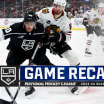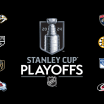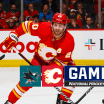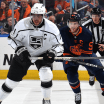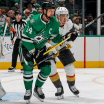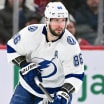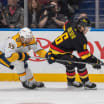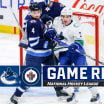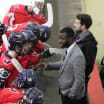The New York Rangers are off to a 14-5-1 start and lead the Metropolitan Division with 29 points. That is no easy feat given that last season's Stanley Cup Champions, the Pittsburgh Penguins, and Presidents' Trophy winners, the Washington Capitals are in the same division.
The most remarkable aspect of the Rangers' success is how well they are performing offensively. New York leads the NHL with 4.05 goals per game, which is up from 2.84 last season. The Rangers have scored at least five goals in 10 of their 20 games this season, matching the number of times they did so in 82 games last season.
Rangers offense fun to watch, hard to figure
Numbers don't tell whole story behind New York's NHL-leading 4.05 goals per game

By
Rob Vollman / NHL.com Correspondent
Where is all this extra scoring coming from? The Rangers are taking roughly the same number of shots as they have in the past, but New York's shooting percentage increased from 10.0 percent in 2015-16, to 13.7 percent this season. Based on the 592 shots the Rangers have taken, the net impact of their 3.7 percent improvement equals 22 more goals in 20 games.
There are a number of ways that a team can increase its shooting percentage, but in the modern age of NHL parity, it is virtually impossible for teams to corner the market on enough talent to maintain that large an advantage over the long term.
The simplest way to increase a team's shooting percentage is with significant changes to the lineup. For example, it would be reasonable to expect a team's shooting percentage to markedly improve if Steven Stamkos of the Tampa Bay Lightning or Sidney Crosby of the Pittsburgh Penguins were added to the roster.
At first glance, that appears to be what is happening in New York, since most of the extra scoring has come from the Rangers' young, fast players added during the offseason. So far this season, 37.3 percent of New York's shots have been taken from new additions, who have a combined shooting percentage of 16.3 percent. That's where the scoring boost is coming from, since those who were on the roster last season have improved their combined shooting percentage from 11.2 percent in 2015-16 to 12.1 percent this season.
However, a deeper examination into their past reveals that the Rangers' newest players weren't expected to score on so many of their shots.
New York's three rookies, Jimmy Vesey, Pavel Buchnevich, and Brady Skjei, have scored a combined 11 goals on 74 shots, a 14.8 shooting percentage. Based on their shooting percentages in the NCAA, KHL, and the American Hockey League last season, they were expected to score on no more than 11.3 percent of their shots, safely assuming that NHL goalies are at least as hard to score against.
The Rangers' six veteran additions, Michael Grabner, Mika Zibanejad (currently injured), Brandon Pirri, Josh Jooris, Nick Holden and Adam Clendening, have scored 25 goals on 147 shots, a combined shooting percentage of 17.0 percent. Based on their shooting percentages last year, they were expected to score on a combined 8.2 percent of their shots.
That means New York's additional scoring hasn't been a product of improving its roster, but of finding ways for these new players to score on a higher percentage of their shots.
The key to discovering ways to raise a team's shooting percentage starts with studying the game situations in which they improve. For example, the League-average shooting percentage at 5-on-5 is 7.6 percent, which improves to 12.3 percent when a team is on a 5-on-4 power play. The Rangers are shooting 12.4 percent at even strength and 14.1 percent at 5-on-4.
What causes shooting percentages to rise in such situations? When a team has the man-advantage, its shooting percentages improve not just because its best offensive players on the ice, but also because those players have the time and space to set up high-quality shots. Power-play shots are taken closer to the net, are more likely to be taken off the rush, after a pass, a cross-ice play and/or with a screen, and result in more rebounds, deflections, and offensive zone faceoffs.
Have the Rangers found the secret to creating these advantages in all game situations? If they have, then it's not in a way that can be easily uncovered by the underlying numbers, and may therefore be a temporary hot streak.
There is still a long way to go to accurately measure if a team's youth and speed are creating more dangerous scoring opportunities. For example, shot quality factors like screens and passes aren't included in official NHL game records, and shot location data for Madison Square Garden is unreliable.
There are some metrics that have helped identify teams whose grit and speed have elevated their shot quality, but none of them apply to the Rangers. For example, the Rangers are tied with the Minnesota Wild, Columbus Blue Jackets, and Dallas Stars for eighth with 46 rebounds, and with the Capitals for 12th with 51 shots off the rush, according to the estimates compiled by Corsica Hockey. That further suggests that the Rangers have not unlocked the secret to improved shot quality, and may have enjoyed some early puck luck.
If the Rangers were employing youth, speed and various game strategies to improve the quality of their shots, then it would be more obvious to both the eye and the numbers, and the impact would be more uniform throughout the lineup. Plus, any shot-quality advantage they may have has already been factored into last season's shooting percentage of 10.0 percent, which was the Rangers' highest since the 2005-06 season (10.2 percent).
In international tournaments, less-balanced leagues, and the more free-wheeling periods in the NHL's history, it is possible for some teams to consistently score on more of their shots than every other team by cornering the market on the youth, speed and shooting talent required to boost shot quality. Since that's not measurably the case for the Rangers, expect their scoring to decline back down toward their normal levels sooner rather than later.
